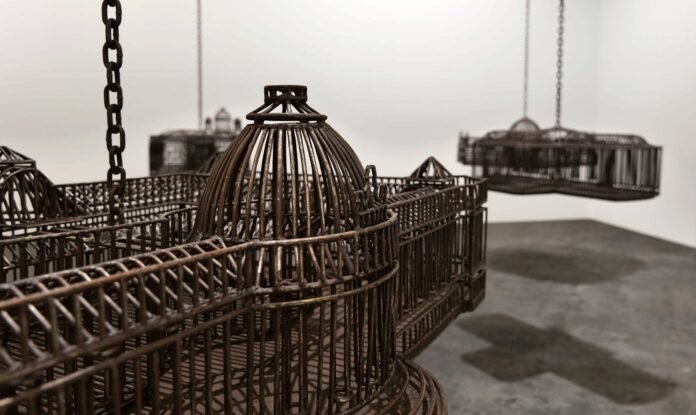Known for bold, chiaroscuro paintings that reimagine European art historical masterworks in his own likeness, Roméo Mivekannin is interested in the Western, colonial gaze on Africa and the power of archives to reveal underrepresented or untold stories. Born on the Ivory Coast, Mivekannin splits his time between Toulouse, France, and Cotonou, Benin. His practice interrogates visibility, appropriation, and power dynamics through direct and unflinching pieces spanning acrylic painting, installation, and sculpture.
At Art Basel last weekend, in collaboration with Galerie Barbara Thumm and Cécile Fakhoury, Mivekannin presented a large-scale installation titled Atlas, comprising a series of metal buildings suspended from the ceiling. Modeled after institutional buildings—in this case, museums that house enthographic collections—the artist draws attention to the colonialist practices and ethical gray areas that permeate these spaces and their histories.

Often founded upon controversial or dubiously-acquired personal collections of European urban elites, larger museums historically emphasized what was seen as “primitive” or “exotic,” exhibiting a skewed view of world cultures framed by a colonialist mindset. The British Museum, for example, was established in 1753 upon the death of Sir Hans Sloane, whose collection of more than 80,000 “natural and artificial rarities” provided the institution’s foundation. His wealth—and his collection—was amassed in part through enslaved labor on his sugar plantations in Jamaica.
Another well-known example of problematic collections include thousands of Benin Bronzes, housed in European institutions like the British Museum and others. British forces acquired many of these elaborately decorated plaques through pillage and looting in the late 19th century. Today, some museums have agreed to repatriate the bronzes to redress this historical indignity (the British Museum is still in discussions).
As a student of both art and architecture, Mivekannin taps into the way certain structures and built environments are designed to convey prestige and dominance. He is also currently pursuing a Ph.D. at the National Superior School of Architecture of Montpellier (ENSAM).
In Atlas, the structures take on the form of bird cages suspended from chains. Both elements symbolize captivity, likening ethnographic collections that often include human remains to what the Atlas exhibition statement describes as “human zoos.” In this context, the cages “serve as a reminder of the historical practices that sought to control and exploit ‘the Other.’”

Mivekannin bridges past and present in this installation, inviting viewers to walk around the museums within a space that shifts the power dynamic. The work encourages viewers “to confront uncomfortable truths about colonial legacies and their ongoing impact on our contemporary society.”
The artist scales down the museums’ palatial details to a diminutive size, displayed low, taking into consideration a kind of meta experience of the exhibition itself. In Mivekannin’s portrayal, the structures are both the cages and the caged.
A show of the artist’s paintings, Black Mirror, is currently on view at Collezione Maramotti in Reggio Emilia, Italy, through July 27. See more on the artist’s Instagram.













